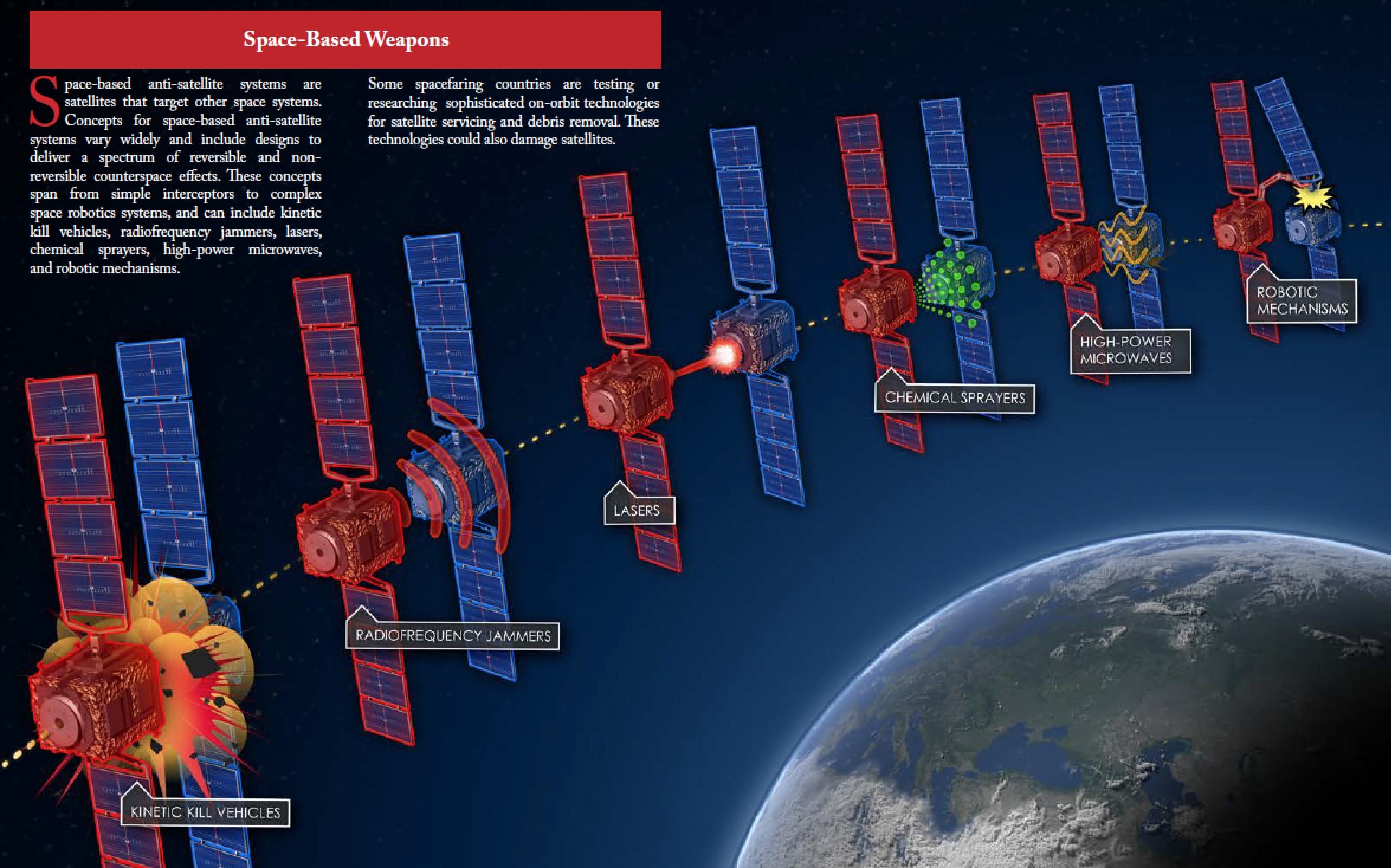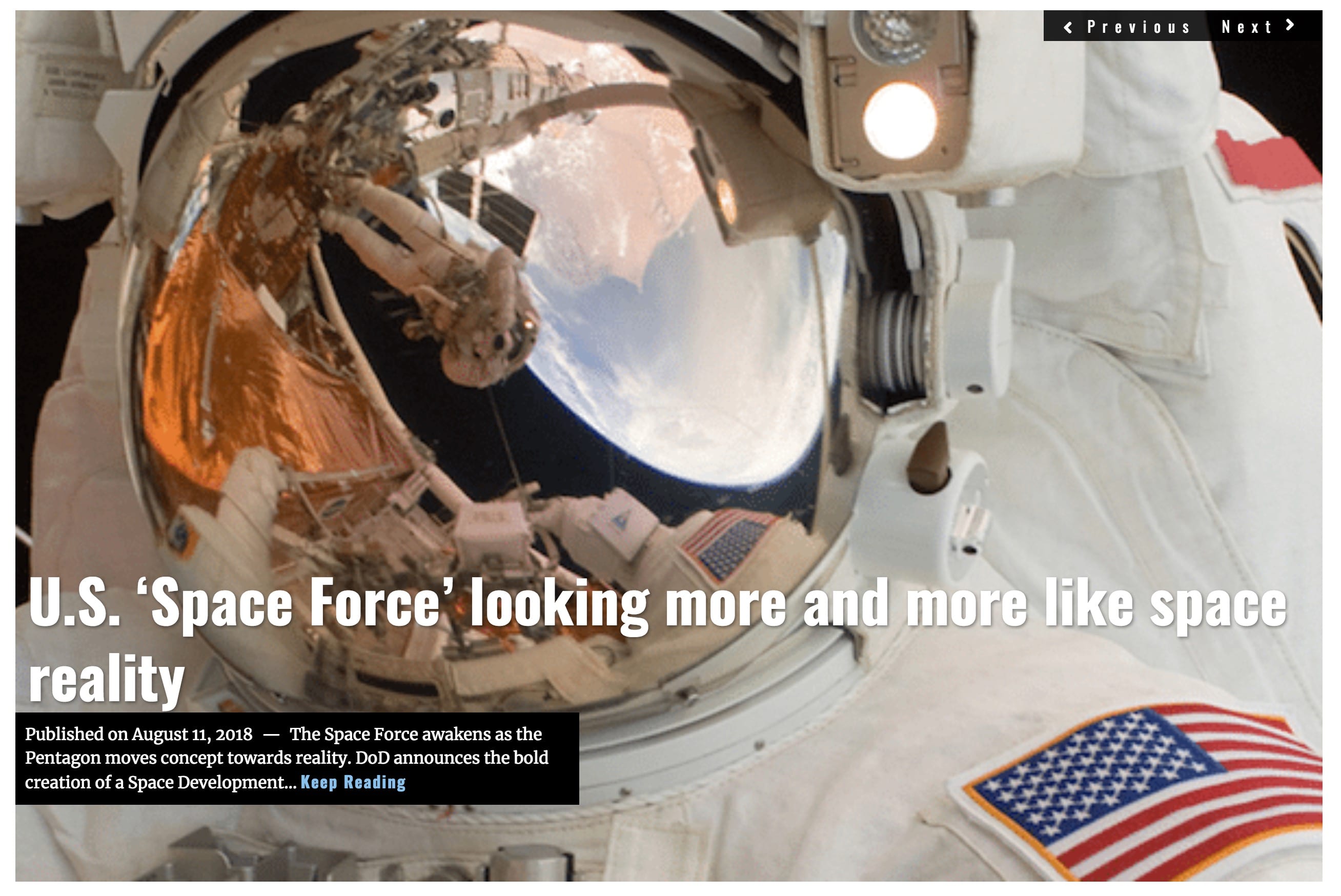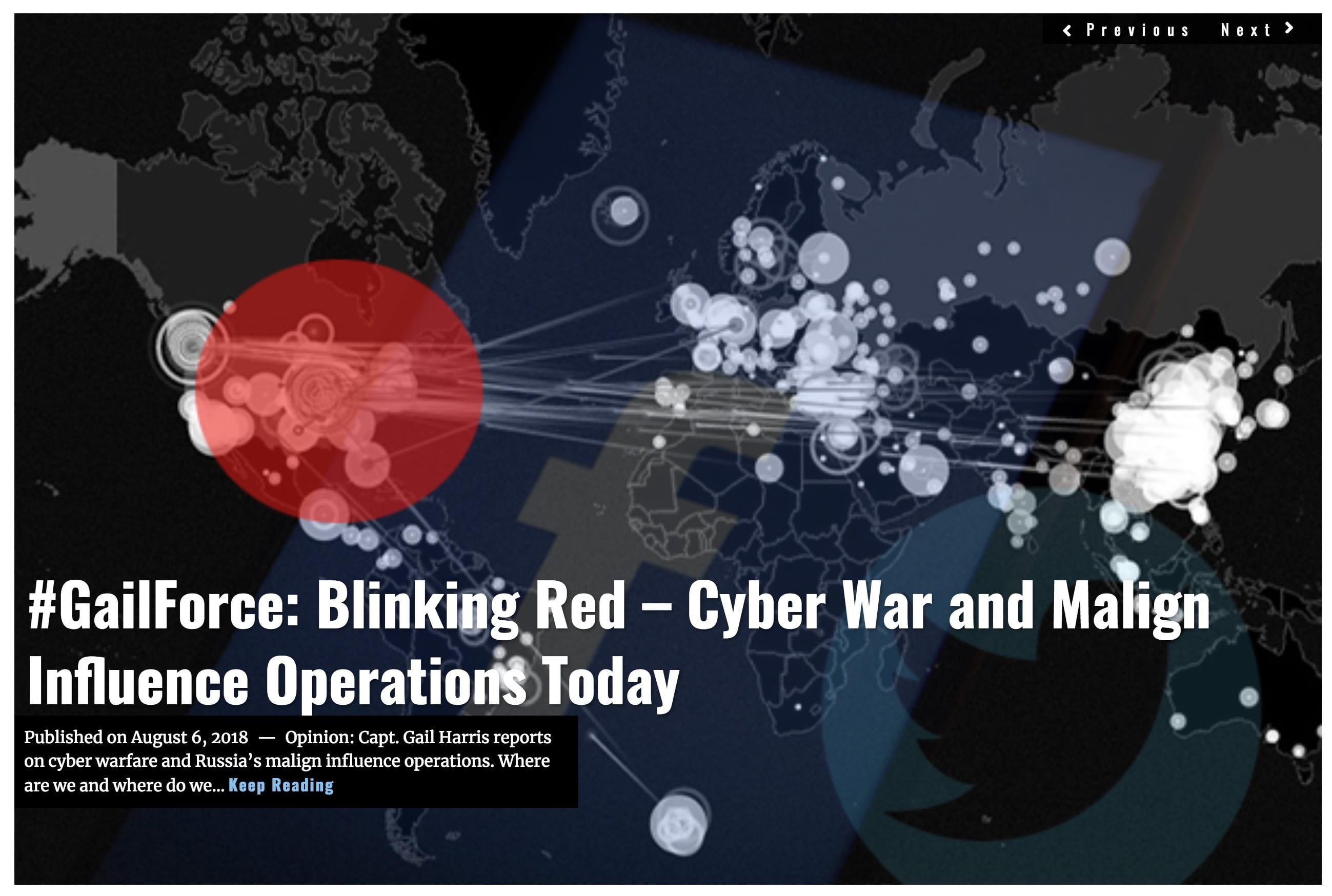The weaponization of space has become a heated topic as debate intensifies over President Trump’s proposed Space Force. Reporting from this year’s Space Symposium, an annual conference for the global space community, Capt. Gail Harris (#GailForce) joins the debate.
When Lima Charlie’s Editor-in-Chief, Anthony LoPresti, asked me to cover this year’s Space Symposium in Colorado Springs, my initial response was NO. I’d already been traveling extensively this year, which included a stint in Airport Hell courtesy of Colorado’s Bomb Cyclone weather event. I was tired. I was also suffering from spring allergies and simply wanted to stay where I was and stare at spring from the privacy of my home in Durango.
Now Anthony could sell ice to someone living in Antarctica so after packing up a huge supply of Kleenex and allergy meds, I reluctantly agreed to go and I drove over to Colorado Springs. Glad I did, it was an awesome event and covered space from every possible angle. While there is so much to report on, my focus for this article is the Department of Defense issues that jumped out at me.
Both China and Russia have weaponized space with the intent to hold American space capabilities at risk … The threat is clear. We’re in an era of great power competition. And the next major conflict may be won or lost in space.”
-Acting U.S. Secretary of Defense Patrick M. Shanahan
Acting Secretary of Defense Patrick Shanahan opened the Space Symposium and got right down to it saying:
We must confront reality. Weapons are currently deployed by our competitors, that can attack our assets in space.
This should come as no surprise to those who track intelligence issues. Each year the Intelligence Community presents a worldwide threat assessment to Congress. This year’s report concerning space stated, “We assess that China and Russia are training and equipping their military space forces and fielding new anti-satellite (ASAT) weapons to hold US and allied space services at risk, even as they push for international agreements on the non-weaponization of space.” The report listed the following primary concerns:
- Both Russia and China recognize the world’s growing reliance on space “and view the capability to attack space services as a part of their broader efforts to deter an adversary from or defeat one in combat.”
- China’s People’s Liberation Army (PLA) has an operational ground-based ASAT missile intended to target low-Earth-orbit satellites, and China probably intends to pursue additional ASAT weapons capable of destroying satellites up to geosynchronous Earth orbit.
- Russia is developing a similar ground-launched ASAT missile system for targeting low-Earth orbit that is likely to be operational within the next several years. It has fielded a ground-based laser weapon, probably intended to blind or damage sensitive space-based optical sensors, such as those used for remote sensing.
- China’s and Russia’s proposals for international agreements on the non-weaponization of space do not cover multiple issues connected to the ASAT weapons they are developing and deploying, “which has allowed them to pursue space warfare capabilities while maintaining the position that space must remain weapons free.”
Some may say, is this just the DoD building up an excuse to get yet more money, and why should the average American care?

“Society increasingly depends on the services provided by satellites. What if GPS and other services were unreliable or unavailable? Police, firefighters, and paramedics, who rely on satellite navigation, would be slow or unable to respond in an emergency. Live news from across the country or the other side of the planet would no longer be available. Long-distance telephone, satellite television, and internet would be unavailable. Retail stores and gas stations could not communicate with banks to complete transactions. Many critical services and daily conveniences we rely on could be affected by weapons targeting our space services.”
In a January 2019 publication, Challenges to Security in Space, the Defense Intelligence Agency (DIA) reported that when a U.S. communication satellite went out in 1998, “people were unable to pay for gas, hospitals were unable to contact physicians who relied on pagers, and television stations were unable to deliver programming.”
Speaking to this issue during the Space Symposium, Air Force Secretary Dr. Heather Wilson remarked:
“Thirty-three of our satellites deliver the position, navigation, and timing for the world, and provide the timing signal for the ATMs and the New York Stock Exchange. If you needed GPS directions to find a restaurant this week, you can thank about 40 airmen sitting 20 miles from here at Schriever Air Force Base. They provide GPS to the world — to a billion people — every day. And their average age is 22.”
One thing the ongoing Cyber War has shown is that a nation state can and will take actions that affect the civilian population, with the influence operations conducted by Russia during the 2016 presidential elections being Exhibit A.
![Image [To-scale drawings of the US reconnaissance satellites (credit Guiseppe De Chiara). Note the precise layout of the KH-11 is speculative - satelliteobservation.net]](https://limacharlienews.com/wp-content/uploads/2019/05/US-Satellite-recon-.jpg)
Satellites, Space Missions, and a Space Force
At the Space Symposium Shanahan said that just as we developed a Naval force to ensure freedom of the seas we now need to develop a space force to “ensure free navigation of the stars”.
The Space Force is the Department of Defense strategy for achieving this. It will consist of three parts: U.S. Space Force, U.S. Space Command and the Space Development Agency (SDA). U.S. Space Force will join the Army, Navy, Air Force, Marine Corp, and Coast Guard as the sixth branch of our armed forces and will be responsible for organizing, training, and equipping the military force. The force will consist of 15,000 – 20,000 people who will initially be drawn from existing commands.
The second part consists of the joint combatant command, U.S. Space Command, which is currently operating as part of United States Strategic Command (STRATCOM). In a later presentation, STRATCOM Commander, General John Hyten, said that currently Space Command is never higher than his third priority. STRATCOM oversees our nuclear arsenal and he explained the necessity of never taking his attention from that. Both he and Shanahan stated that the urgency of the space issue now requires a leader than can focus 100% of his time on the problem.
SDA will focus on developing next generation systems while also working with organizations already developing new satellites and equipment. I suspect this will be an area with the potential for turf wars and controversy. It was also the only area of Space Force where not all the Department of Defense speakers seemed to be on the same page.
RT @DeptofDefense: For 41 years, the Global Positioning System has helped us find our way. It’s a system that our modern way of life depends on every day. Now the @usairforce is working to improve & update the GPS to keep us navigating into the future. pic.twitter.com/JcJ45OP3VT
— United States Strategic Command (@US_STRATCOM) April 27, 2019
Dr. Fred Kennedy, former head of Defense Advanced Research Projects Agency (DARPA) has just been appointed head of SDA. He outlined a plan for using large constellations of small satellites in low earth orbits (LEO) to take over military space missions. It wasn’t clear to me whether he meant all military missions or just some.
I suspect this is where the turf wars will be heaviest.
If you needed GPS directions to find a restaurant this week, you can thank about 40 airmen sitting 20 miles from here at Schriever Air Force Base. They provide GPS to the world — to a billion people — every day. And their average age is 22.”
-Air Force Secretary Dr. Heather Wilson
Before I go on, here is an explanation of satellite orbits, the altitude they fly at and what missions they conduct as defined in the DIA publication, Challenges to Security in Space.
LEO satellites fly at altitudes up to 2,000 km are used for communication, intelligence surveillance and reconnaissance (ISR), and human space flight. Medium Earth Orbit (MEO) satellites fly from approximately 2000 – 35,000 km and are used for communications, position navigation, and timing. Highly Elliptical Orbit (HEO) satellites vary in orbit from LEO when nearest to earth (perigee) and approximately 40,000 km when farthest from earth (apogee) and are uses for communications, ISR, and missile warning. Geosynchronous earth orbit satellites fly at approximately 36,000 km above the earth and are used for communications, ISR, and missile warning.
The DIA publication points out that the advantage of higher orbits for communications and ISR satellites is the “near persistent coverage” of most of the earth, while there is limited access to the polar regions. And while LEO satellites cover all parts of the world, including the poles, they do so for shorter periods based on the speed of the satellite. DIA states that with the exception of nine U.S. Apollo missions to the Moon, all human spaceflights have been completed in LEO.
![Image [Graphic courtesy of Defense Intelligence Agency]](https://limacharlienews.com/wp-content/uploads/2019/05/GEO-MEO-HEO-satellites.png)
Overcoming Risk and Threat
During his remarks, Dr. Kennedy also said SDA represented a move from the DoD’s risk adverse culture, stating that the DoD has been resistant to changes in space acquisition policies and roles and responsibilities are fragmented. He said he would have a refined plan by the end of the year.
General Hyten also talked about risk. At the question and answer session he said we had to understand how to take risks and still move forward, citing the Apollo program as an example. He said there was “a lot of merit” to the LEO concept but more work was needed on the concept to determine what would work.
Air Force Secretary Wilson, however, appeared to me to rebut some of Dr. Kennedy’s points regarding LEOs:
“Let me be clear. The United States Air Force is funding the development of low-earth orbit systems and commercially-based systems for some of our missions. But launching hundreds of cheap satellites a year, as a substitute for the complex architectures where we provide capabilities to the war fighter, will result in failure on America’s worst day, if we rely upon them alone.”
Dr. Wilson emphasized that “threat drives strategy” and pointed out that the Air Force had just completed a 90 day study working with DoD, the Joint Staff, all services, DARPA, the NRO, and “all of the relevant OSD offices, as well as Combatant Commands.”
We looked at all of our missions in space, from missile warning to communications and intelligence collection. We took the best estimates of the threat, and presumed a thinking adversary who will respond to the actions that we take. We embedded red teams to push ourselves on our own assumptions, and we ran thousands of iterations of war games and simulations and different phases of conflict with different potential future architectures, to decide what we need for the future.
Because of classification reasons she couldn’t share all the conclusions, but she said that some of those reached were: different space missions require different solutions (“one size does not fit all”); simply increasing the numbers of satellites alone won’t work; and space missions not well-aligned with commercial low-earth orbit satellites are “better off staying where they are or making other changes to protect themselves”.
I asked General Hyten if there were plans for STRATCOM to incorporate the intelligence community’s assets and efforts into the Space Force. He said they were taking 180 days to look at the relationship with the intelligence community. I’d like to be a fly on the wall for those discussions.
Another reason I’d been reluctant to attend the Space Symposium is because many of the sessions on topics I was most interested in were restricted to those with security clearance. I understand the reasons for that but there is much information available at the unclassified level that would help educate and inform the public and academia.
The efforts of the intelligence community in space starting after World War II under the direction and support of President Eisenhower is one of the greatest military stories in the history of the world. My statement is not hype but fact. Those efforts are one of the primary reasons we won the Cold War and continue to be the dominant military force in the world today, although that’s now being challenged…but that’s another article. Much of those efforts are still classified but information is now starting to trickle out.
An excellent book on this topic is The Wizards of Langley: Inside the CIA’s Directorate of Science and Technology by Jeffrey T. Richelson. More about why I think this is very relevant to today’s space efforts at the end of this article when I throw in my two cents on the Space Force.
Dr. Wilson alluded to these efforts during her talk while discussing the space threat:
“China is deploying satellite jammers. Operationally-based anti-satellite weapons. And directed energy weapons. Russia is developing ground-launched missiles, directed energy weapons, and sophisticated satellites to interfere with our satellites on orbit. Why are they doing this? Because America is the best in the world at space, and our adversaries know it. To remain dominant in space, we recognize the need to change our strategies, and our programs supporting those strategies. We’ve accomplished much over the last two years, but there is still much more to do.”

Acquisition at the speed of light
The Department of Defense’s acquisition policies have been acknowledged by all to be at times cumbersome and ineffective. Everyone always talks about fixing it and there have been some steps taken to solve it, but much remains to be done. I would however be remiss in not also stating that many people have been doing heroic work in overcoming these obstacles and getting new system hardware, software, and equipment to the folks on the pointy end of the spear that need them.
During her talk, Dr. Wilson detailed steps the Air Force has taken during her tenure.
We will not win a war against a rapidly-innovating adversary with an acquisition system from the Cold War. We are driving changes to field tomorrow’s Air Force faster and smarter. Last summer, we set a goal for ourselves. We decided we were gonna strip 100 years of unnecessary schedule time out of Air Force program plans. A hundred years. So far, we’ve stripped out almost 80 years. The interesting thing is 21-1/2 of those years were in space programs. Space programs alone. And much of the credit for that work goes to the Space and Missile Systems Center.
We are using new authorities, given to us by the Congress, to build and test and deploy things faster. Those authorities have been given back to the services because the Congress understood that we cannot centralize control if we’re going to meet a rapidly-innovating adversary. We must be able to move acquisition at speed.
My only concern is Dr. Wilson is stepping down this month and my hope is that her successor has the same visionary attitude that she does.
Thou shall not fly space mission components that have not been successfully operated in the spacelike environment including tests of shock, temperature, vibration, acceleration, humidity, altitude, noise and life.”
‘Air Force specifications’ – Ingard Clausen
Intelligence, Surveillance, Reconnaissance
Now for my final remarks.
In the winter time, I proudly wander around with a green hoodie with the initials NRO on it. Oddly enough, no one has ever asked me what the letters stood for or where I got it. I’m sure if they had asked, they would not have understood the significance. The letters stand for National Reconnaissance Office and as they say on their web site: the NRO was secretly created on September 6, 1961 with the purpose of overseeing “all satellite and overflight reconnaissance projects whether overt or covert.”
It was 1978 when President Carter informed the public that the U.S. carried out reconnaissance on our enemies and potential enemies from space, and 1992 when NRO’s existence was acknowledged.
During her talk, Dr. Wilson said Desert Storm was the first time that airmen, soldiers, sailors and marines recognized the value of our space systems on their missions. It was the first space war.
I respectively disagree with the last part. Military use of space has been there since the beginning and I would submit that the Cold War was the first space war. As World War II ended and the Cold War began the U.S. realized there was a huge gap in knowledge of both the Soviet Union’s military capabilities and their intensions. This intensified when the Soviet Union detonated a nuclear device in 1949. There were questions whether the Soviet Union had missiles and bombers that could reach targets in the U.S. After the successful launch of Sputnik there was widespread concern of a missile gap. The greatest fear was the possibility of a surprise attack.
At this time, Navy and Air Force aircraft were conducting reconnaissance flights along the Soviet Union’s periphery. They were able to provide valuable information but not at the level of detail that flights over the Soviet Union could deliver. Additionally, flights along the periphery were incredibly dangerous. I don’t have the figures for the Air Force but the Navy lost many aircraft and 90 sailors lost their lives in these efforts. The heroic efforts of these flight crews were done under the utmost levels of secrecy so the public was not aware of those that made the ultimate sacrifice during these highly risky flights.
In 1954, President Eisenhower appointed a Technical Capabilities Panel to come up with options for dealing with the threat. The first option was manned reconnaissance flights. This led to development of the U-2. The U-2 could successfully fly over the Soviet Union but eventually became endangered by improving Soviet Air Defenses. It bears mentioning that the U-2 and Navy and Air Force reconnaissance aircraft continued to fly along the periphery and both services still conduct manned reconnaissance flights today along with the more publicized drone flights.
![Image Galactic Radiation and Background (GRAB-1) satellite (National Air and Space Museum - Smithsonian Institution)]](https://limacharlienews.com/wp-content/uploads/2019/05/Grab-1-satellite-NASM-2006-3298.01.jpg)
On June 22, 1960, an Air Force launch vehicle successfully put a Navy satellite, code name “Grab 1” designed to detect electronic intelligence (ELINT) into space. It flew over the Soviet Union successfully detecting air defense radar emitters. It became the first successful reconnaissance satellite.
In August 1960, the U.S. launched the first reconnaissance satellite (program name “Corona”) capable of providing imagery (IMINT) of Soviet military forces and bases. Even more significant it took 13 tries to get it right. Twelve earlier missions failed because of technical issues and challenges. (Source: The National Reconnaissance Office at 50 Years, A Brief History).
Speaking in Tennessee in 1967, President Johnson acknowledged that Corona had been developed in only 16 months to become the first photoreconnaissance satellite. “The spy satellite filled in the gaping holes in the U.S. knowledge about Soviet nuclear armaments during the hottest part of the Cold War.”
Speaking at a 1999 Conference titled, US Intelligence and the End of the Cold War, former CIA Head and future Secretary of Defense, Robert Gates stated, “If ever legends and stories of American technological genius were deserved and not yet realized, they would be about the scientists and engineers, the wizards of CIA and American intelligence who pioneered reconnaissance aircraft like the U-2 and the SR-71, photographic satellites from the KH-4 to the KH-11, an amazing array of signals intelligence satellites and people who worked brilliantly but anonymously to serve their country.” Gates added, “As they targeted one of the most secretive countries in the world, it is a tribute to these remarkable men and women that, beginning in the 1960s, there were virtually no further Soviet military surprises of strategic importance.”
Ingard Clausen, the first project manager for General Electric’s Corona Satellite Recovery Vehicle, made what I believe are key points on the Corona program’s success, which are also very relevant for our future space success:
“[L]et me define ‘risky race.’ The race was to meet President Eisenhower’s edict to fly a photoreconnaissance satellite in one year and bring back film from space in two years. The risk arose because no one could have met Eisenhower’s one-year schedule and still conduct business as usual. If we had been compelled to follow Air Force specifications for qualifying designs and for accepting hardware for space flights, we would not have succeeded. The Air Force specifications or ‘laws’ were, ‘thou shall not fly space mission components that have not been successfully operated in the spacelike environment including tests of shock, temperature, vibration, acceleration, humidity, altitude, noise and life.’”
The U.S. military success during Desert Storm shook up the military strategists of the world. They watched the U.S. coalition use tactics like precision bombing while news reports showed cruise missiles zig zagging around buildings and other structures on the way to targets.
Today per the National Air and Space Intelligence Center, over 38 countries have satellites in space with an ISR and remote sensing capability. The U.S. has 353, China 122, and Russia 23. Although they can be used for civil and commercial uses, it is the military uses that are a concern. What does this mean?
Just as our ISR satellites give us the capability to track and monitor threats from space, so do their systems. We must stay ahead. Speaker after speaker emphasized the importance of partnerships with industry and allies. This included the necessity of embracing risk in the development of new space technologies and equipment.
Just as important, a potential enemy must know that not only does the U.S. and its allies have effective systems in place, but an attack on its satellites will result in a response they will not like – and I’m not talking about economic sanctions. Bottom line for me, while the debate continues, I think the Space Force is a good idea to achieve our goals and is part of an evolutionary process on operating safely in space.
Just my thoughts. Think I’ll end here.
Gail Harris, for LIMA CHARLIE WORLD
Captain Gail Harris (U.S. Navy, Ret.), was the highest-ranking African American female officer in the US Navy at the time of her retirement in 2001. Her 28 year career in intelligence included hands-on leadership during every major conflict from the Cold War, to El Salvador, to Desert Storm, to Kosovo, and she was at the forefront of one of the Department of Defense’s newest challenges, Cyber Warfare. Gail also writes for the Foreign Policy Association, is author of “A Woman’s War”, served as Senior Fellow for the George Washington Center For Cyber & Homeland Security (2015-2017) and is a Senior Advisor for the Truman National Security Project.
Follow Capt. Harris on Twitter @GailHarrisLC
[Subscribe to our newsletter for free and be the first to get Lima Charlie World updates delivered right to your inbox.]
Lima Charlie World provides global news, featuring insight & analysis by military veterans, intelligence professionals and foreign policy experts Worldwide.
For up-to-date news, please follow us on twitter at @LimaCharlieNews
In case you missed it:

![Image GailForce to Space Force: 'Make it so' - the Space Force debate continues [Lima Charlie News]](https://limacharlienews.com/wp-content/uploads/2019/05/Space-Force-01.png)




![Image World Press Freedom Day has us asking ‘What is the state of free press in democracies worldwide, and why has America’s free press ranking dropped?' [Lima Charlie News]](https://limacharlienews.com/wp-content/uploads/2019/05/World-Press-Freedom-Day-01-480x384.png)
![Image Imagine a Global Space Community ... The Space Foundation Can [Lima Charlie News][Graphic by Anthony A. LoPresti]](https://limacharlienews.com/wp-content/uploads/2019/03/Space-Foundation-Space-Symposium-Lima-Charlie-News-480x384.png)



![Image Memorial Day may soon be a remembrance of democracy and those who had the courage to defend it [Lima Charlie News]](https://limacharlienews.com/wp-content/uploads/2018/05/Memorial-Day-may-soon-be-a-remembrance-of-democracy-and-those-who-had-the-courage-to-defend-it-Lima-Charlie-News-480x384.png)
![The Mind of Bolton - AUMF and the New Iran War [Lima Charlie News]](https://limacharlienews.com/wp-content/uploads/2019/05/Inside-the-mind-of-Bolton-Lima-Charlie-News-main-01-480x384.png)

![Image World Press Freedom Day has us asking ‘What is the state of free press in democracies worldwide, and why has America’s free press ranking dropped?' [Lima Charlie News]](https://limacharlienews.com/wp-content/uploads/2019/05/World-Press-Freedom-Day-01-150x100.png)
This is impressive